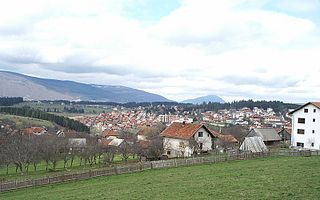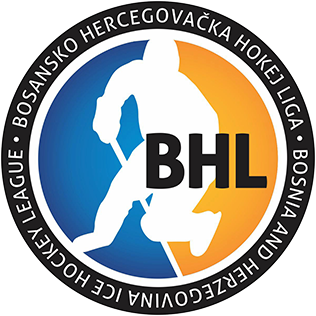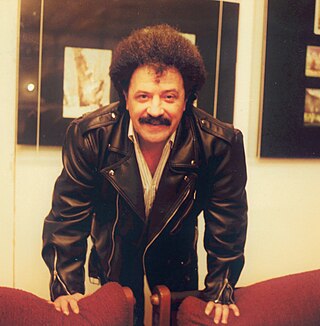
Sarajevo is the capital and largest city of Bosnia and Herzegovina, with a population of 275,524 in its administrative limits. The Sarajevo metropolitan area including Sarajevo Canton, East Sarajevo and nearby municipalities is home to 555,210 inhabitants. Located within the greater Sarajevo valley of Bosnia, it is surrounded by the Dinaric Alps and situated along the Miljacka River in the heart of the Balkans, a region of Southern Europe.

The 1984 Winter Olympics, officially known as the XIV Olympic Winter Games and commonly known as Sarajevo '84, were a winter multi-sport event held between 8 and 19 February 1984 in Sarajevo, Yugoslavia. It was the first Winter Olympic Games held in a Slavic language-speaking country, as well as the only Winter Olympics held in a communist country before the 2022 Winter Olympics in Beijing, China. It was the second consecutive Olympic Games held in a communist country, after the 1980 Summer Olympics in Moscow, Russian SFSR, Soviet Union.

FK Sarajevo is a professional football club based in Sarajevo, the capital city of Bosnia and Herzegovina and is one of the most successful clubs in the country.

Centar is a municipality of the city of Sarajevo, Bosnia and Herzegovina. It is located between the older parts of the city under Stari Grad, and the newer more modern parts of the city under the municipalities Novi Grad and Novo Sarajevo.

Novi Grad is a municipality of the city of Sarajevo, Bosnia and Herzegovina. It is the westernmost of the four municipalities that make up the city of Sarajevo. The municipality also consists of the villages Bojnik and Rečica.

Stari Grad is a municipality of the city of Sarajevo, Bosnia and Herzegovina. It is the oldest and most historically significant part of Sarajevo. At its heart is the Baščaršija, the old town market sector where the city was founded by Ottoman general Isa-Beg Ishaković in the 15th century.

Baščaršija is Sarajevo's old bazaar and the historical and cultural center of the city. Baščaršija was built in the 15th century when Isa-Beg Ishaković founded the city.
The architecture of Bosnia and Herzegovina is largely influenced by four major periods, when political and social changes determined the creation of distinct cultural and architectural habits of the region.

Tourism in Bosnia and Herzegovina is a fast-growing sector making up an important part in the economy of the country.

Kneževo, formerly Skender Vakuf, is a town and municipality located in Republika Srpska, Bosnia and Herzegovina. As of 2013, it has a population of 9,793 inhabitants.

The Bosnia and Herzegovina Hockey League (BHL) is the top league for ice hockey in Bosnia and Herzegovina. It is organized by the Bosnia and Herzegovina Ice Hockey Federation.
Skender is a male given name.
For the 1984 Winter Olympics in Sarajevo, Yugoslavia, a total of nine sports venues were used. The idea for the Games came around from a 1968 Organisation for Economic Co-operation and Development study on promoting winter tourism in Yugoslavia. After Sarajevo was awarded the 1984 Games in 1978, venue construction and renovation took place between 1979 and 1983. Weather postponed the men's downhill alpine skiing event three times before it was finally run. The men's cross-country skiing 30 km event was run during a blizzard. After the games, all but one of the venues were damaged during the Bosnian War and the siege of Sarajevo. After the war, Zetra Ice Hall was rebuilt and is in use as of 2010.

Sarajevo Olympic Bobsleigh and Luge Track is a bobsleigh and luge track situated on Trebević mountain overlooking the City of Sarajevo, built for the 1984 Winter Olympics.

Živorad "Žika" Janković (1924–1990) was a Yugoslav and Bosnian architect.

KK Bosna Meridianbet is a professional basketball team based in Sarajevo, Bosnia and Herzegovina. It is the most successful Bosnian club of all time, having been the EuroLeague champion by winning the 1978–79 FIBA European Champions Cup. The club competes in the Basketball Championship of Bosnia and Herzegovina. It is part of the University Sport Society USD Bosna.

Muslihudin Čekrekčija Mosque, also known as Čaršijska, is second oldest domed mosque in Sarajevo. It was constructed in 1526 in the Baščaršija area of the city, at the foot of Kovač. It is raised in the mahala of Isa-Bey's turn. From the vakufnam of the founder of the mosque, Hajji Mustafa, the son of Ishak, is known to the people as Muslihudin Čekrekčija, her builder. This is also the oldest known original document written in Sarajevo.

Želimir "Čičak" Altarac was a Bosnian singer-songwriter from Sarajevo.

Dom Mladih is a multifunctional venue of modern concept and interior, located in Sarajevo, Bosnia and Herzegovina, as part of Skenderija, which is equipped with state-of-the-art technology, consisting of a dance hall with a capacity of 2000 visitors and the amphitheater with a capacity of up to 600 visitors.

Trg oslobođenja - Alija Izetbegović is a square in Sarajevo, Bosnia and Herzegovina. It lies between the municipalities Stari Grad and Centar. It links the main pedestrian thoroughfare of the Sarajevo old town, Ferhadija street, with Zelenih Beretki street, with the Dom Armije (1881). On its east side it hosts the Orthodox Cathedral (1874) and the University of Sarajevo School of Economics and Business. On its west is the Svjetlost building, while at its south, beyond Zelenih Beretki, stands the Dom Armije (1881)




















